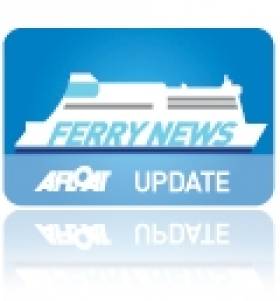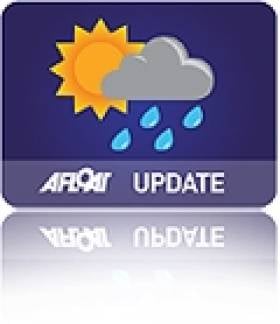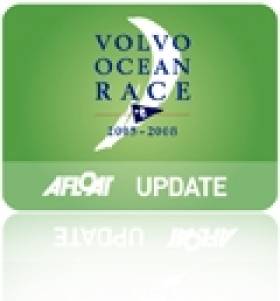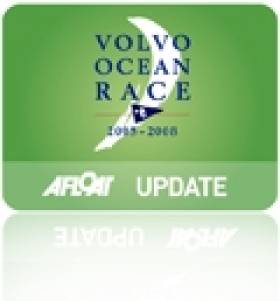Displaying items by tag: damage
#STORMS – May Day and the first day of Summer 2012 today brings little in the way of joy for boaters on the east coast of Ireland at least who have suffered early season set backs from gales since the beginning of April. Prolonged storm force winds and big seas have wrecked boats, equipment, jetties and piers along the coast.
Many yachts and boats are now safely sheltered in the capital's marinas at Dun Laoghaire, Malahide and Howth but sadly for other skippers it is too late and the 2012 season lies in tatters.
Today's forecast shows another poor week in prospect and while the weather is to improve for next weekend's bank holiday it is not to the extent that it will be a memorable one with cold northerly winds forecast and temperatures of only 9 degrees until next Tueday at least. It seems hard to imagine that in March Ireland was basking in temperatures in the low 20s.
Storm damage is still being assessed in Skerries and Bray where most of the damage has occurred.
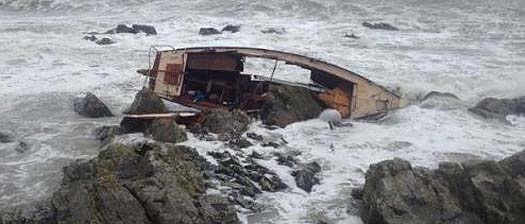
Yachts lie wrecked on the rocks in North Dublin. Photos: Dean Jacobs
Less than a week since the boats were craned in at Skerries Sailing Club ISORA champion yacht Raging Bull, skippered by Matt Davis, was on the rocks.
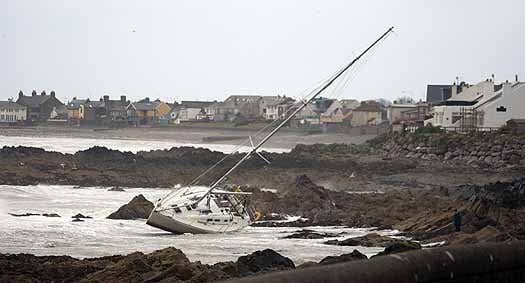
The yacht was among others to be washed ashore in Skerries in north Dublin when moorings apparently broke in the extreme conditions.
In Bray Co. Wickow, no sooner had crews lifted boats in than the crane was back in action lifting Sailing Club yachts out of the harbour again only some were not so lucky.
There is little doubt about the severtiy of the storms that even caused problems in Dun Laoghaire, Co. Dublin where the yacht club pontoon at the Royal St. George Yacht Club was damaged in the first of the storms.
Amazingly through all of this yacht club racing programmes have been followed without a hitch except for the SB3s scrubbed last Sunday. Howth concluded its Spring Warmer series, DBSC has had two great Saturday race days and in between gales the ISORA fleet raced 47 miles from Dun Laoghaire to Wicklow and back.
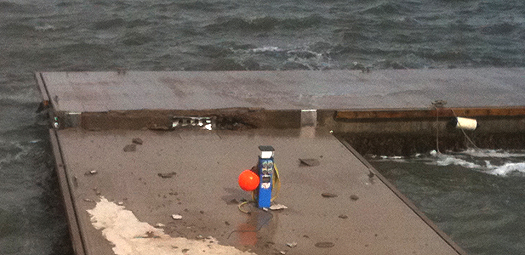
Damage to yacht club pontoons inside Dun Laoghaire harbour
The new harbour in Greystones was also tested this month and there were many onlookers. The consensus appears that it s been well built but over-topping (where waves can crash over the top of the brekwaters) might make berths in the new marina basin inhospitable when the marina is eventually installed there.
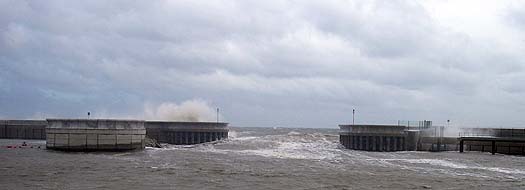
Waves crash over the new harbour walls in Greystones in the first week of April
We are documenting the damage to boats causd by the gales. If you have photos or videos please send them to [email protected]
Collision Captain's Case Sent to Crown Court
#FERRY NEWS - BBC News reports that the captain of the cargo ship that collided with a passenger ferry in Belfast Lough could face up to two years in prison as his case has been sent to Crown Court.
Miroslaw Pozniak, 55, pleaded guilty on Friday to the charge of 'excess alcohol by the master of a ship' after the cargo vessel Union Moon collided with the Stena Feronia close to the Fairway buoy on Wednesday.
Both vessels were substantially damaged in the incident but there are no reports of injuries.
Newtownards Court heard yesterday that Pozniak has been fired by his employer. He will remain in custody until 20 March when the judge will again consider bail.
Ireland Battered by Storm-Force Winds
#WEATHER - Ireland has been warned to brace for further strong winds set to sweep across the country today (4 January),
The Irish Times reports. Winds reaching near hurricane speeds have affected coastal communities in the north and northwest, peaking at a remarkable 168km/h in Donegal.
Thousands of euro worth of damage was caused when the roofs of traditional thatched cottages at Cruit Island in west Donegal were blown away.
But the west and east have also been hard hit, with storm-force gales exceeding 100km/h uprooting trees and disrupting electricity supply.
As previously reported on Afloat.ie, ferry services on the east coast have been severely affected. Irish Ferries cancelled two fast ferries from Dublin to Holyhead yesterday, and today's early Jonathan Swift sailings between Dublin and Holyhead were also cancelled.
Met Éireann expects wind speeds to be lower today, but could still reach 90-120km/h in some areas.
The Irish Times has much more on the story HERE.
Team Sanya Hitches a Ride to Capetown (Photo)
#SANYA– Definitely not as intended but neverthless on her way to Cape Town as our picture shows. The Discover Ireland backed Sanya entry in the Volvo Ocean Race has been successfully repaired and is ready to joing the other six yachts in the fleet. The 70-foot yacht suffered hull damage only hours into the race. Still to arrive is Puma, the third boat in the fleet to have suffered damage in the first leg.
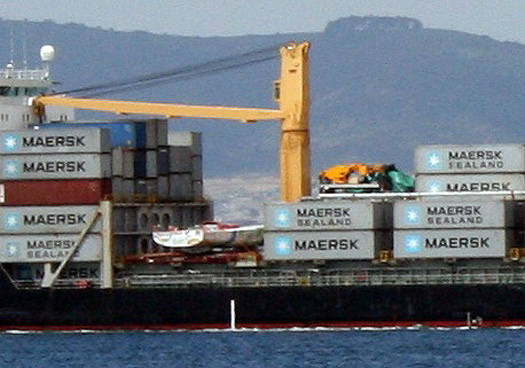
Afloat again and heading for Capetown. Team Sanya is repaired and spotted on a cargo ship
Sanya Hull Damage First Photos Here!
#SANYA HULL DAMAGE – Team Sanya crew were driven back to Alicante to the team hotel they have called home for the past few weeks. For most, their families are still here. The damage to the boat is plain for all to see.
Team Sanya are weighing up the different options available to them which include repairing the boat in Spain or shipping her directly to Cape Town and carry out the repairs there. A final decision will be made later today.
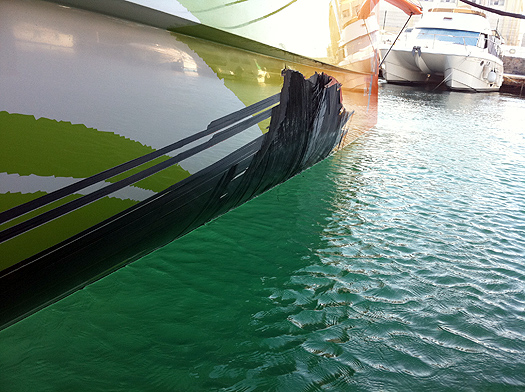
Above and below Sanya's smashed hull - Photo: Team Sanya
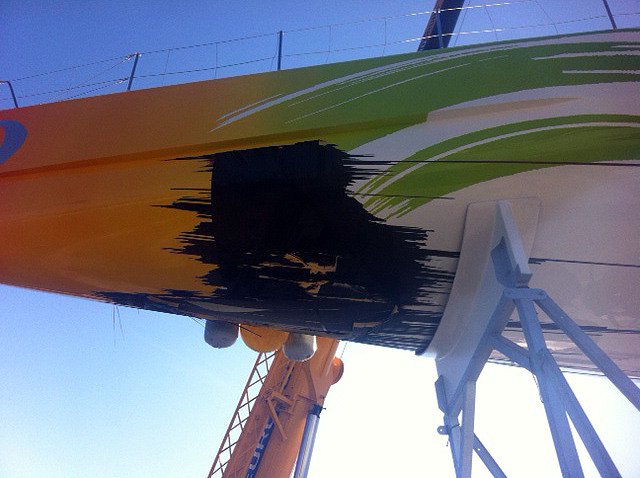
In a completely separate incident during a dramatic sail change yesterday, Team Sanya Bowman Andy Meiklejohn sustained an injury to his foot. He has now had the time to have that injury assessed and the hospital have indeed confirmed that he has broken his foot.
The hope is Andy's foot will have healed and be strong enough to be onboard for the 11th December start of Leg 2.
Wicklow Boatyard at the Cutting Edge
Afloat magazine profiles Noonan Boats, one of the country’s leading repair facilities
From collision damage, keel fairing right up to osmosis treatments and re-sprays, Noonan boatyard in Newcastle, Greystones Co. Wicklow offers such a comprehensive service on the East Coast there is little need for any boat to go abroad for repairs these days, regardless of the extent of damage.
And news of the quality work has been spreading with boats from the four coasts Ireland coming to Wicklow for a range of work.
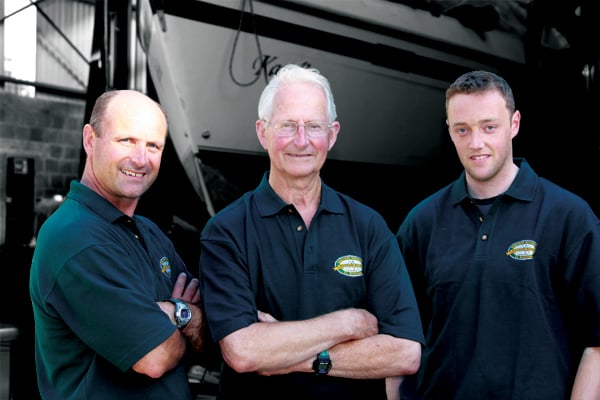
Graeme Noonan (left) has extensive big boat repair experience from his time in the marine industry in Sydney, Australia and is an active RS sailor. Founder Tony Noonan (centre) has spent a lifetime in the Irish Marine industry with Neil Watson Yachts, Wicklow Marine Services before setting up Noonan Boats in 1995. Brian Flahive is an active dinghy and keelboat sailor this year finished second in the Round Ireland double-handed class and won the Fireball National Championships.
Father and son team Tony and Graeme Noonan have over 30 years in the business and have recently expanded the premises to over 3,000 sq feet to cater for a growing range of repair work for boats up to 50 feet under cover.
They have a well-established reputation for the treatment of osmosis, to resolve hull blistering. This is a preventative and remedial process that requires specialist treatment.
The bulk of repair work comes from along the East Coast based boats and the nearby port of Dun Laoghaire but the company offers a national service to include transport to and from the Noonan boatyard if required.
“We have an established track record dealing with Insurance companies. No job is too difficult, too small or too big for us” says Tony Noonan.
Most work is carried out in in a purpose-built marine workshop containing two lifting bay facilities that includes keel and rudder repair pits but the firm also carries out on site repairs to suit too.
Repairs are carried out to original specifications and they carry out re-moulding repairs to up to date construction methods e.g. GRP foam core, Balsa core and carbon under vacuum bagging conditions.
A particular speciality is the repair of carbon repairs to dinghy masts, spinnaker poles and hulls. This has become more popular recently with the advent of carbon bowsprits on boats such as the J109s and SB3s.
Keel fairing, the process of improving the accuracy of the shape of a keel to improve boat speed is also high on the jobs list.
The company also has the specialist hot weld equipment to carry out the repair of polyethylene materials as used in the RS Feva and Laser Pico dinghies.
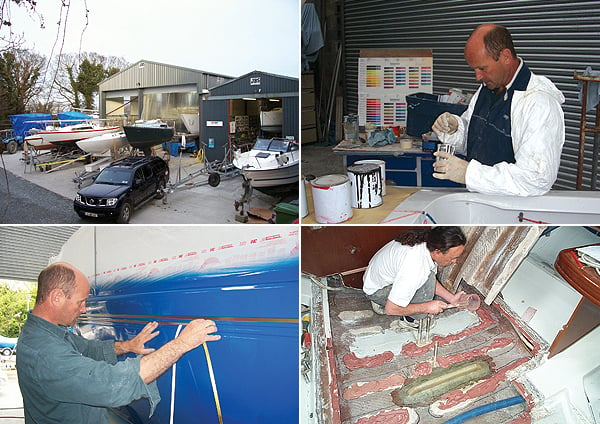
Colour Matching
Making a fibreglass repair to bring a boat back to original specification is one thing but matching gel coat to weathered or faded paintwork is quite another. Noonan Boatyard cosmetically match gels to present colour so the repair can appear practically invisible.
Polyethelene Repair
Plastic boats are durable but they can split and crack. Repairing them requires specialist heat gun welding equipment
Repair and re-spray
Weathered topsides, especially darker colours, always benefit from a re-spray, tired areas including decks and non-skid areas can also be re-sprayed
Floor matrix repair
After a keel grounding with rocks, for example, damage to a floor matrix may not be immediately visible but it is vital that inner frames are checked and repaired
Osmosis treatment, hot vac and copper coat
The yard uses the latest technology in the treatment of osmosis. Hulls are gel-planed to expose lay up prior to a HOT- VAC process and drying. This can be the stage where copper coat is an economical choice. It ends the need for the expensive and unpleasant annual chore of cleaning and repainting a boat’s hull. Simply hose down the hull at regular intervals, commonly once a year, to remove any build-up of sea-slime. We currently have two examples in our yard at present which show after one year and after ten years of immersion – and still working. Come and see for yourself!
Fully Repaired, Tried and Tested
Noonan Boats completed extensive repairs to Oystercatcher, a Gibsea 37, and when this work was completed the firm entered the boat in the gruelling 704-mile race round Ireland.
Local sailors Brian Flahive (Fireball National Champion) who works at the yard and Bryan Byrne manned what was Wicklow Sailing Club’s first ever yacht to entry into the doubled handed class of the Race. Dubbed the ‘Pride of Newcastle’ the entry finished an impressive winner of IRC III and Cruiser Class IV. The pair also finished second in the two handed class.
It was no easy journey but certainly the repairs stood up to the job, a case of repair work being tried, tested and proven!
The Boatyard, Sea Road, Newcastle, Greystones, Co. Wicklow
Tel/Fax: 01 281 9175 • Mobile: 086 170 8875
Email: [email protected]
- boats
- Wicklow
- RS Feva
- Dun Laoghaire
- Greystones
- collision
- Brian Flahive
- noonans boats
- wicklow boatyard
- boat repair
- keel fairing
- osmosis
- Newcastle
- Neil Watson
- Graeme Noonan
- Tony Noonan
- repair
- hull blistering
- Insurance
- lifting bay
- workshop
- GRP
- vacuum bagging
- carbon repairs
- dinghy masts
- spinnaker poles
- Laser Pico
- Polyethelene Repair
- respray
- Floor matrix
- hot vac
- copper coat
- Repaired
- damage



























